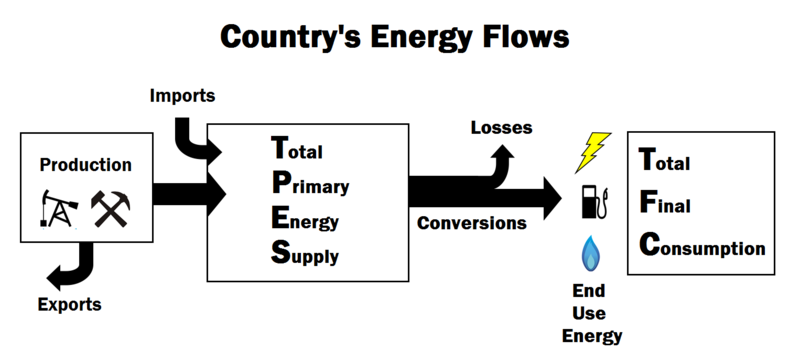Primary energy
Primary energy is the energy that's harvested directly from natural resources. Sources of primary energy fall into two basic categories, primary fuels and primary energy flows (see fuel vs flow for a detailed discussion). The fuels in primary energy are all primary fuels. A country's different sources of primary energy are aggregated into a quantity called total primary energy supply (TPES). All of human energy must come from one of these primary energy sources, there are no energy alternatives. Primary energy is contrasted with end use energy (for a full discussion please see primary vs end use accounting). Primary energy almost always needs to be converted through an energy conversion technology to make this primary energy source into an energy currency or a secondary fuel before it can be used.

For example:
- Crude oil must be put through an oil refinery before it turns into secondary fuel (useable fuel) like gasoline, diesel or kerosene.
- Coal is usually put into a coal-fired power plant to generate electricity
- Wind must be harnessed by a wind turbine before it can generate electricity
Crude oil, coal, wind and natural gas are all primary energy sources. Electricity is not a primary energy source, it's an energy currency (see electricity as an energy currency for an in depth discussion). Likewise, secondary fuels are also energy currencies and aren't primary energy sources, they must be made.
Most of the world's primary energy (~95%) comes from fuels, most of which are fossil fuels, see figure 1. This means that most of the world's energy supply emits carbon dioxide when it undergoes combustion in order to extract the energy. The world's primary energy is growing quite rapidly (even faster than population in most countries), specifically in rapidly growing economies like the BRIC countries, play with the interactive graph to see more.
Figure 2. Approximately 95% percent of the primary energy in the world comes from fuels like oil, coal and natural gas[2] (all of which except nuclear fuels produce extensive greenhouse gases when used). Most of the rest of the primary energy comes from hydropower with a small fraction is wind power, solar power, wave power and tidal power (the flows are roughly 5% shown, as the extracted pie pieces). The amount of electricity that comes from flows increases to about 19% (still mostly hydro) because flows don't have the same limitations of having a thermal efficiency's that heat engines have and flows are used almost entirely for electricity generation.
Interactive Graph
Play with the following interactive graphic to see how primary energy is increasing in different regions and countries. Use the drop down menus to change which view is shown (population doesn't work on regions yet). The units on the graph are millions of tonnes of oil equivalent (Mtoe), which is the energy in 1 million tonnes of oil.
For Further Reading
- Electricity as an energy currency
- Energy
- End use energy
- Energy use by sector
- Total final consumption
- Or explore a random page
References
- ↑ Created internally by a member of the Energy Education team.
- ↑ IEA (2014), "World energy balances", IEA World Energy Statistics and Balances (database). DOI: http://dx.doi.org/10.1787/data-00512-en (Accessed February 2015)

